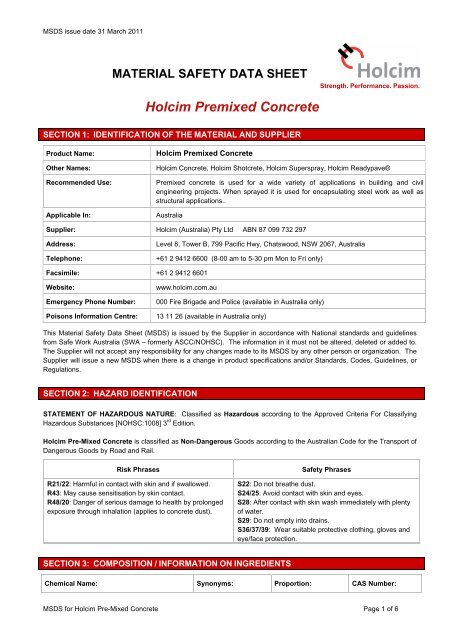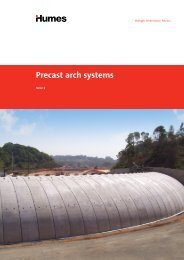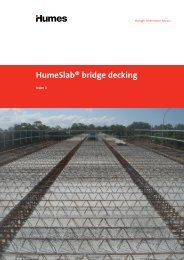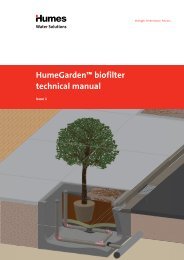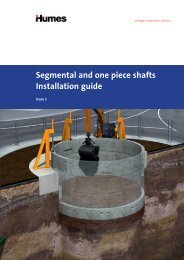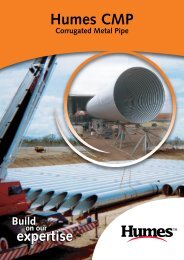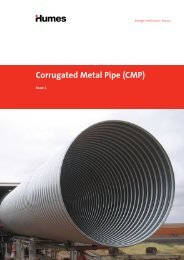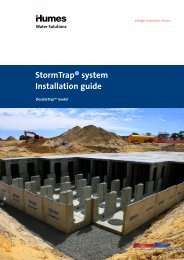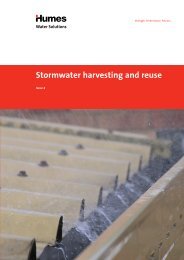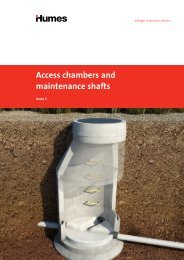Holcim Premixed Concrete
Holcim Premixed Concrete
Holcim Premixed Concrete
You also want an ePaper? Increase the reach of your titles
YUMPU automatically turns print PDFs into web optimized ePapers that Google loves.
MSDS issue date 31 March 2011MATERIAL SAFETY DATA SHEETStrength. Performance. Passion.<strong>Holcim</strong> <strong>Premixed</strong> <strong>Concrete</strong>SECTION 1: IDENTIFICATION OF THE MATERIAL AND SUPPLIERProduct Name:Other Names:Recommended Use:Applicable In:<strong>Holcim</strong> <strong>Premixed</strong> <strong>Concrete</strong><strong>Holcim</strong> <strong>Concrete</strong>, <strong>Holcim</strong> Shotcrete, <strong>Holcim</strong> Superspray, <strong>Holcim</strong> Readypave®<strong>Premixed</strong> concrete is used for a wide variety of applications in building and civilengineering projects. When sprayed it is used for encapsulating steel work as well asstructural applications..AustraliaSupplier: <strong>Holcim</strong> (Australia) Pty Ltd ABN 87 099 732 297Address:Telephone:Level 8, Tower B, 799 Pacific Hwy, Chatswood, NSW 2067, Australia+61 2 9412 6600 (8-00 am to 5-30 pm Mon to Fri only)Facsimile: +61 2 9412 6601Website:Emergency Phone Number:Poisons Information Centre:www.holcim.com.au000 Fire Brigade and Police (available in Australia only)13 11 26 (available in Australia only)This Material Safety Data Sheet (MSDS) is issued by the Supplier in accordance with National standards and guidelinesfrom Safe Work Australia (SWA – formerly ASCC/NOHSC). The information in it must not be altered, deleted or added to.The Supplier will not accept any responsibility for any changes made to its MSDS by any other person or organization. TheSupplier will issue a new MSDS when there is a change in product specifications and/or Standards, Codes, Guidelines, orRegulations.SECTION 2: HAZARD IDENTIFICATIONSTATEMENT OF HAZARDOUS NATURE: Classified as Hazardous according to the Approved Criteria For ClassifyingHazardous Substances [NOHSC:1008] 3 rd Edition.<strong>Holcim</strong> Pre-Mixed <strong>Concrete</strong> is classified as Non-Dangerous Goods according to the Australian Code for the Transport ofDangerous Goods by Road and Rail.Risk PhrasesR21/22: Harmful in contact with skin and if swallowed.R43: May cause sensitisation by skin contact.R48/20: Danger of serious damage to health by prolongedexposure through inhalation (applies to concrete dust).Safety PhrasesS22: Do not breathe dust.S24/25: Avoid contact with skin and eyes.S28: After contact with skin wash immediately with plentyof water.S29: Do not empty into drains.S36/37/39: Wear suitable protective clothing, gloves andeye/face protection.SECTION 3: COMPOSITION / INFORMATION ON INGREDIENTSChemical Name: Synonyms: Proportion: CAS Number:MSDS for <strong>Holcim</strong> Pre-Mixed <strong>Concrete</strong> Page 1 of 6
Portland cement 10-60% 65997-15-1Aggregate containing crystalline silica (quartz)Sand, crushed stone,gravel, slag>85% 14808-60-7Water
Emergency Procedures:Methods and materials forcontainment and clean up:Recommendations on exposure control and personal protection should be followedduring spill clean-up.If spillage is dry, shovel into containers. Avoid generating dust. If spillage is wet,shovel into containers and then wash down area with water, but prevent run-offfrom entering storm water and sewer drains and watercourses.SECTION 7: HANDLING AND STORAGEPrecautions for safe handling:Conditions for safe storage:Incompatibilities:Wet concrete is a heavy material, and appropriate control of manual handling risk isrequired when barrowing, shovelling or carrying quantities of wet concrete. Manualhandling should be in accordance with Manual Handling Regulations and Codes.Wet premixed concrete has a limited life after batching and will set hard. The rateof setting depends on the ambient conditions and amount of agitation. May bestored for very short periods of time (less than twenty minutes) in self-cleansinghoppers with sides at an angle of at least 45° to the horizontal.Contact with sugars, acids or solutions of either will cause a serious degradation ofthe quality of the material. A safety hazard is created by such contact due to thepotential failure of the structure being constructed. Similarly, handling andtransporting the material at temperatures less than 0°C or greater than 30°C maycause a degradation of the quality of the material with a consequent safety hazardarising from the potential failure of the structure being constructed.SECTION 8: EXPOSURE CONTROLS / PERSONAL PROTECTIONNational Exposure Standards:National Occupational Exposure Standard (NES), Safe Work Australia(formerly ASCC/NOHSC)Crystalline silica (quartz): TWA – 0.1 mg/m 3 respirable dust. (≤ 7 micronsparticle equivalent aerodynamic diameter)Notes on Exposure Standards:All occupational exposures to atmospheric contaminants should be kept to aslow a level as is workable (practicable) and in all cases to below the NationalStandard.TWA (Time Weighted Average): the time-weighted average airborneconcentration over an eight-hour working day, for a five-day working week overan entire working life. According to current knowledge this concentration shouldneither impair the health of, nor cause undue discomfort to, nearly all workers.Biological Limit Values:No biological limit allocated.ENGINEERING CONTROLS Ventilation: If placing concrete in enclosed areas or a confined space, ensure adequateforced ventilation. Local mechanical ventilation may be required in areas wherespray droplets from wet concrete or dry dust could escape into the workenvironment.Special Consideration forRepair &/or Maintenance ofContaminated Equipment:Recommendations on Exposure Control and Personal Protection should befollowed. When dry concrete dust is present, ensure exposures to respirablecrystalline silica (quartz) are maintained below NES.PERSONAL PROTECTION Personal Hygiene: Wash hands before eating, drinking, using the toilet, or smoking. Wash workclothes regularly. Skin Protection: Minimise contact with concrete materials. Never kneel in wet concrete, or allowextended contact of skin with wet concrete.When handling wet concrete, mortar or grout, personnel should wear looseMSDS for <strong>Holcim</strong> Pre-Mixed <strong>Concrete</strong> Page 3 of 6
comfortable protective clothing and impervious boots, (AS/NZS 4501), suitableimpervious gloves such as PVC (AS 2161).Remove clothing which has become contaminated with wet or dry concrete toavoid prolonged contact with the skin. If concrete gets into boots, remove socksand boots immediately and wash skin thoroughly. Eye Protection: Avoid contact with eyes. Splash resistant safety glasses with side shields,safety goggles (AS/NZ 1336), or a face-shield should be worn. Respiratory Protection: In dusty environments use a respirator (filter mask) such as Class P1 or P2(AS/NZS 1715 and AS/NZS 1716).SECTION 9: PHYSICAL AND CHEMICAL PROPERTIESAppearance:Odour:Pre-mixed <strong>Concrete</strong> is a plastic mixture of water, cementitious materials, andaggregates (sand, stone or gravel). Plasticity ranges from near liquid topourable slurry to a friable soft solid. The colour is usually grey. If pigments areused, the colour may range from near-white to any other colour.Some added ingredients used in concrete may create a smell of ammonia.pH, at stated concentration: > 7.0Vapour Pressure:Vapour Density (air = 1):Boiling Point/Range (°C):Not applicableNot applicableNot determinedMelting Point (°C): >1200Solubility in water:Not soluble, or slightly soluble.Reacts on mixing with water forming an alkaline (caustic) solution (pH >11).Specific Gravity (H 2 O = 1): 2.5Flash Point:Flammable (Explosive) Limits:Autoignition Temperature:Not applicableNot applicableNot applicableSECTION 10: STABILITY AND REACTIVITYChemical Stability:Conditions to avoid:Stable under normal conditionsKeep away from water – must be kept dryIncompatible Materials: Sugars, acids or solutions of either (see Section 7)Hazardous DecompositionProducts:Hazardous Reactions:NoneNoneSECTION 11: TOXICOLOGICAL INFORMATIONHealth effects information is based on reported effects in use from overseas and Australian reports.Health Effects: Acute (short term)Swallowed:Unlikely in normal use in the industrial situation. Abrasive and highly irritant (burning) to mouthand throat. May cause nausea, and stomach cramps.MSDS for <strong>Holcim</strong> Pre-Mixed <strong>Concrete</strong> Page 4 of 6
Eyes:Skin:Inhaled:Irritating and may cause alkaline (caustic) burns to the eyes. Splash of wet concrete into theeye can cause serious and rapid corrosive burning, with potential for permanent loss of vision.Irritating, abrasive and drying to the skin. May cause alkaline (caustic) burns if direct contact ismade with wet concrete for any length of time, leading to second or even third degree burns.<strong>Concrete</strong> dust is irritating to the nose, throat and respiratory tract causing coughing andsneezing. Pre-existing upper respiratory and lung diseases including asthma and bronchitismay be aggravated.Health Effects: Chronic (long term)Eyes:In dust form it may cause inflammation of the cornea.Skin:Inhaled:Repeated contact causes irritation and drying of the skin and can result in skin reddening andskin rash (dermatitis) which may become persistent. Persons who are allergic to chromium maydevelop an allergic dermatitis.In dust form it may cause inflammation of lining tissue of the respiratory system. Repeatedinhalation of dust containing crystalline silica can cause bronchitis, silicosis (scarring of thelung), and may increase the risk of other serious disorders including scleroderma (a diseaseaffecting the connective tissue of the skin, joints, blood vessels and internal organs).Additional NotesLong Term Effects:Long term occupational over-exposure or prolonged breathing-in (or inhalation) of crystallinesilica dust at levels above the NES carries the risk of causing serious and irreversible lungdisease, including bronchitis, and silicosis (scarring of the lung). It may also increase the risk ofother irreversible and serious disorders including scleroderma (a disease affecting the skin,joints, blood vessels and internal organs) and other auto-immune disorders.SWA has not classified crystalline silica as a carcinogen.Special ToxicEffects:Inhalation of dust, including crystalline silica dust, is considered by medical authorities toincrease the risk of lung disease due to tobacco smoking.SECTION 12: ECOLOGICAL INFORMATIONEco-toxicity:Persistence and Degradability:Mobility:Product forms an alkaline slurry when mixed with water, and heavy contamination ofwater courses and ecologically sensitive land must be avoided.Product is persistent and would have a low degradability.A low mobility would be expected in a landfill situation.SECTION 13: DISPOSAL CONSIDERATIONSDisposal methods andcontainers:Special precautions forlandfill or incineration:Pre-Mixed <strong>Concrete</strong> can be treated as a common waste for disposal in accordance withlocal authority guidelines. Keep out of storm water and sewer drains. Measures should betaken to prevent dust generation during disposal and exposure and personal precautionsshould be observed (see above).Pre-Mixed <strong>Concrete</strong> can be dumped into a landfill site in accordance with local authorityguidelines.SECTION 14: TRANSPORT INFORMATIONUN number:UN Proper Shipping Name:Class and Subsidiary Risk :None allocatedNone allocatedNone allocatedMSDS for <strong>Holcim</strong> Pre-Mixed <strong>Concrete</strong> Page 5 of 6
Packaging Group:Special Precautions for User:HAZCHEM code:None allocatedTransport equipment should be strong enough to contain a fluid with aneffective specific gravity of 2.5.None allocatedSECTION 15: REGULATORY INFORMATIONPoisons Schedule:Not scheduledExposures by inhalation to high levels of dust may be regulated under the Hazardous Substances Regulations (State) asthey are applicable to Respirable Crystalline Silica, requiring exposure assessment, controls and health surveillance(ASCC/NOHSC).SECTION 16: OTHER INFORMATIONDate of last revision of this MSDS: 31 March 2011Australian Standards References:AS/NZS 1336Recommended Practices for Occupational Eye ProtectionAS/NZS 1715AS/NZS 1716AS 2161Selection, Use and Maintenance of Respiratory Protective DevicesRespiratory Protective DevicesIndustrial Safety Gloves and Mittens (excluding electrical and medical gloves)Other References:NOHSC:2011(2003)NOHSC:10005(1999)NOHSC:2007(1994)NOHSC:2012(1994)NESADG CodeNational Code of Practice for the Preparation of Material Safety Data Sheets 2 nd Edition, April2003, National Occupational Health and Safety Commission.List Of Designated Hazardous Substances, April 1999, National Occupational Health andSafety Commission, Sydney.National Code of Practice for the Control of Workplace Hazardous Substances (AustralianStates have similar Codes of Practice in each State).National Code of Practice for the Labelling of Workplace Substances, March 1994, AustralianGovernment Publishing Service, Canberra.National Occupational Exposure Standards for Workplace Atmospheric Contaminants (NES)Australian Safety and Compensation Council, ASCC (formerly NOHSC) 1995 as amended.Australian Dangerous Goods Code 7 th Edition.Whilst the information contained in this document is based on data which, to the best of our knowledge, was accurate andreliable at the time of preparation, no responsibility can be accepted by us for errors and omissions. The provision of thisinformation should not be construed as a recommendation to use any of our products in violation of any patent rights or inbreach of any statute or regulation. Users are advised to make their own determination as to the suitability of thisinformation in relation to their particular purposes and specific circumstances. Since the information contained in thisdocument may be applied under conditions beyond our control, no responsibility can be accepted by us for any loss ordamage caused by any person acting or refraining from action as a result of this information.END OF MSDSMSDS for <strong>Holcim</strong> Pre-Mixed <strong>Concrete</strong> Page 6 of 6


